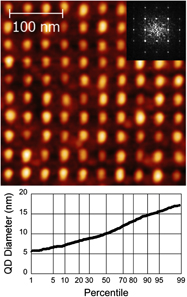Article contents
Formation and thermal stability of 2D ordered SiC/Si(001) nanodots
Published online by Cambridge University Press: 28 December 2012
Abstract

Precise spatial ordering of quantum dots (QDs) may enable predictable quantum states due to direct exchange interactions of confined carriers. The realization of predictable quantum states may lead to unique functionalities such as spin cluster qubits and spintronic band gap systems. To define exemplary quantum architectures, one must develop control over QD size and spatial arrangement on the sub-35-nm length scale. We use fine-probe electron beam irradiation to locally decompose ambient hydrocarbons onto a bare Si(001) surface. These carbonaceous patterns are annealed in ultrahigh vacuum (UHV), forming ordered arrays of nanoscale SiC QDs. We have achieved sub-10-nm diameter epitaxially oriented 3C-SiC nanodots with interdot spacings down to 22.5 nm. We investigate the templated feature evolution during UHV annealing and subsequent Ge epitaxial overgrowth to identify key mechanisms that must be controlled to preserve pattern fidelity and reduce broadening of the nanodot distribution.
- Type
- Articles
- Information
- Journal of Materials Research , Volume 28 , Issue 2: Focus Section: Silicon-based Nanoparticles for Biosensing and Biomedical Applications , 28 January 2013 , pp. 261 - 267
- Copyright
- Copyright © Materials Research Society 2012
References
REFERENCES
- 2
- Cited by




